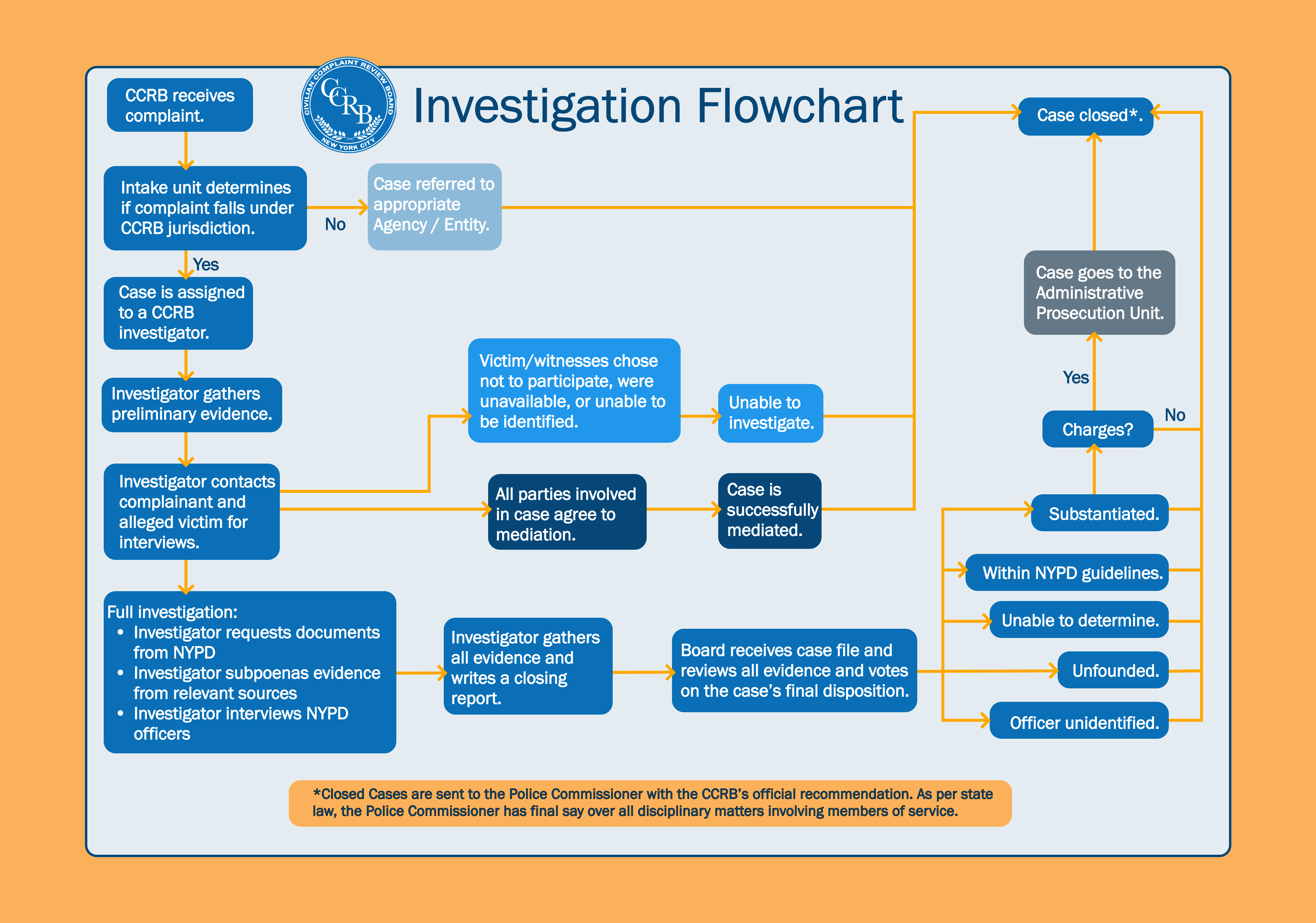
 Civilian Complaint Review Board311
Civilian Complaint Review Board311 Search all NYC.gov websites
Search all NYC.gov websites
Complaint Process:
File a complaint:
- Any victim or witness of NYPD misconduct can file a complaint with the CCRB online, on the phone, through the mail, or in person. You can also tag or direct message the CCRB on social media if you believe you have seen evidence of misconduct.
Learn more about how to file a complaint here.
Intake:
- After you file your complaint, the CCRB’s intake unit will determine if it falls within the Agency’s jurisdiction.
- If your complaint is not in our jurisdiction, it is referred to the appropriate agency or entity to investigate the incident.
Learn more about CCRB jurisdiction here.
In-person statement
- After your complaint is filed, a CCRB investigator will need to interview you to obtain an accurate and thorough description of the events and alleged misconduct that led to your complaint. Interviews happen by phone, virtually, or in-person at CCRB headquarters located at 100 Church St., in Manhattan. If necessary, interviews can be conducted at locations in all five boroughs.
- Your in-person statement is the foundation of the investigation. On the day of your statement, try to bring as much information as possible about your complaint, such as:
- Time, date, and location of the incident.
- Badge numbers, names, and physical descriptions of the police officers involved.The CCRB has access to police department records, such as roll calls, command logs, vehicle assignments, and stop and frisk forms, so we can usually identify officers without a name or badge number.
- Names and contact information for witnesses.
- Any relevant paperwork, photographs, or video.
- To ensure that your case can be administratively prosecuted if the board substantiates the allegations, the investigator will ask you to sign a verification form confirming your statement is truthful and accurate.
- Depending upon the nature of your complaint, the investigator may offer you the opportunity for mediation instead of a full investigation.
Learn more about the mediation process here.
Evidence gathering
- After your initial interview, the investigator assigned to your case will begin gathering evidence. To do so, the investigator will visit the site where the incident occurred to collect all possible evidence. They will search for surveillance cameras, try to find witnesses or any people with knowledge of the incident, and collect any physical evidence at the site. If the incident was posted on social media, the investigator will reach out the accounts associated with the post to try to collect more information.
- The CCRB has subpoena power, which enables us to obtain records from commercial establishments and medical facilities, though we cannot view your medical records without your permission. We are also able to obtain necessary documents from the NYPD. Because the CCRB has access to police department records, such as roll calls, command logs, vehicle assignments, and stop and frisk forms, we can usually identify officers, even if you cannot give us a name or badge number.
NYPD Evidence
- The CCRB can obtain necessary documents from the NYPD such as roll calls, command logs, vehicle assignments, stop and frisk forms and body-worn camera footage.
- CCRB Investigators will interview both the subject police officer, the officer accused of misconduct, and any officers who may have witnessed the incident. Under the NYPD’s Patrol Guide, police officers must appear at the CCRB to be interviewed and must answer investigators’ questions truthfully and fully.
Click here to search redacted closing reports.
Board panel or full board vote
- When an investigation is finished, the entire case file, along with a closing report prepared by the investigator, is given to a panel comprised of three board members— one mayoral designee, one city council designee, and one police commissioner designee. This panel decides on the outcome of the case which is usually one of the following:
- Substantiated
- Within NYPD Guidelines
- Unfounded
- Officer Unidentified
- Unable to Determine
- In particularly complex cases, the full board will convene to determine the outcome of a case.
Learn more about investigation results here.
Disciplinary Process
- If the Board substantiates an allegation of misconduct, it makes a disciplinary recommendation to the Police Commissioner who has final authority over what penalty, if any, should be imposed on the officer. The Board uses the NYPD’s Disciplinary System Penalty Guidelines, often referred to as the Disciplinary Matrix, to the determine its recommendations of discipline.
Learn more about NYPD discipline here.
Administrative Prosecution Unit
- When the Board substantiates the misconduct allegation(s) and recommends Charges and Specifications, the highest level of misconduct, the case gets sent to the Administrative Prosecution Unit (APU).
- The case gets assigned to a prosecutor who prepares for a trial.
- If the Police Commissioner recommends Command Discipline A or B, disciplinary levels that do not automatically warrant the case to go to trial, the subject officer can still elect for the case to go to be tried.
- The APU prosecutes cases before the NYPD Deputy Commissioner of Trials or an Assistant Deputy Commissioner of Trials at One Police Plaza. After the trial, the trial commissioner makes a recommendation to the Police Commissioner. If the recommendation differs from what the CCRB recommended, the CCRB can write a letter to the Police Commissioner reiterating the Agency’s argument for the level of discipline.
- The subject officer can accept a plea offer instead of a trial. If the subject officer chooses to go to trial and is found guilty, the NYPD trial commissioner will recommend a penalty. The Police Commissioner may accept, reject, or modify any plea agreement, trial verdict, or penalty recommendation.



